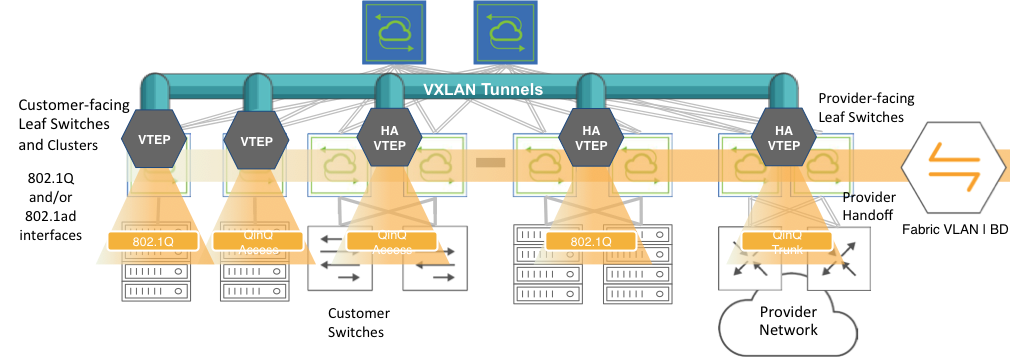
Understanding VXLAN-based Bridge Domains for IEEE 802.1Q and QinQ Internet-working
With the IEEE 802.1Q standard a network design is constrained to 4094 possible VLAN numbers. When more Layer 2 identifiers are needed, and a hierarchy of network entities can be established, the VLAN stacking technology (informally also called QinQ, after the name of Cisco’s original implementation, also known as 802.1Q Tunneling) can be utilized to scale up to 16 million (4094 x 4094) identifiers using two (concatenated, i.e., ‘stacked’) VLAN tags instead of one.
The IEEE organization has standardized the VLAN stacking technology with the Provider Bridges standard, also known as IEEE 802.1ad, which was later incorporated into the IEEE 802.1Q-2011 revision of the LAN/MAN standard.
IEEE 802.1ad refers to providers of services, such as Transparent LAN Services in Metro networks. There are also a number of data center designs that can tap the scalability of the VLAN stacking technology: for example data center networks in which one tag (the so-called outer tag) is used to identify a data center customer, while the second tag (the so-called inner tag) is used to identify a customer service.
With this technology it is possible to identify up to 16 M services for up to 4K customers. The double-tagged traffic is oftentimes handed off to a provider (for example a cloud exchange provider) which can terminate it for end-to-end connectivity. Hence, this scheme can be used to deploy hybrid cloud designs in which private clouds integrate with external clouds.
In practice in such designs QinQ (i.e., VLAN stacking) augments the basic 802.1Q capabilities by massively scaling the number of usable network identifiers organized in a hierarchy.
Arista combines this technology with the VXLAN-based Unified Cloud Fabric to yield an even higher degree of scalability and flexibility. In fact, VXLAN IDs (a.k.a. VNIs) are 24-bit long (vs. 12-bits of VLAN IDs) and therefore are a perfect match for double-tagging Layer 2 network transports.
In addition, VLAN ID to VXLAN ID mappings enable a great degree of flexibility for network designers that Arista substantiates with a new type of configuration object called VXLAN-based bridge domain (BD).
VXLAN-based bridge domains will be supported in a future release of NetVisor OS: they can be mapped to single or multiple 802.1Q VLANs as well as to dual IEEE 802.1ad VLAN tags, covering all possible design requirements.
The different available configuration models for VXLAN-based bridge domains are:
- Single tag mapping, in which an outer VLAN tag (for example, a customer ID) is mapped to a VNI on an IEEE 802.1ad port and the inner VLAN tags are preserved inside the VXLAN encapsulation. This type of mapping can be used on customer facing ‘QinQ access’ interfaces.
- Double tag mapping, in which an outer VLAN + inner VLAN tag pair is mapped to a VNI on an IEEE 802.1ad port (traffic is received double-tagged in ingress and is marked with two tags in egress after VXLAN decapsulation). This type of mapping can be used on multi-VLAN ports (sometimes called QinQ trunks) facing for example an external cloud provider.
- Single 802.1Q tag mapping, in which a single 802.1Q VLAN (or multiple 802.1Q VLANs) are mapped to a common VNI (for example, for inter-DC communication within the same customer’s private cloud network).

Figure 9-3: Hierarchical Fabric Structure Using Bridge Domains for Intra- and Inter-DC Connectivity
The various configuration models of bridge domains yield an unprecedented level of flexibility in terms of advanced Layer 2 transport services, with the ability of re-using VLANs across tenants, supporting QinQ hierarchies and handoff links, as well as aggregating multiple VLANs in the same overlay construct (thus supporting high-scale L2 tenant services).
